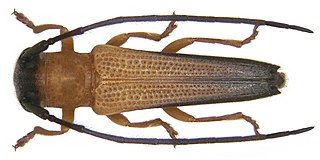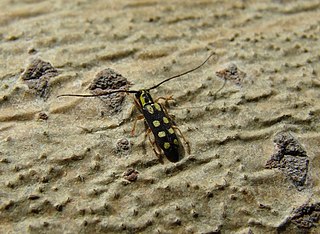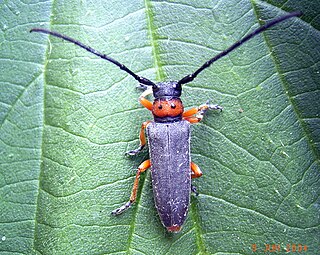
Acalolepta is a genus of flat-faced longhorns beetle belonging to the family Cerambycidae, subfamily Lamiinae. Its members are found in the Indomalayan realm.

Agapanthia is a genus of flat-faced longhorn beetle belonging to the family Cerambycidae, subfamily Lamiinae.

Saperda is a genus of flat-faced longhorn beetles belonging to the family Cerambycidae, subfamily Lamiinae. The genus was erected by Johan Christian Fabricius in 1775.

Saperdini is a tribe of longhorn beetles of the subfamily Lamiinae.

Dorcadion is a genus of longhorn beetles of the subfamily Lamiinae.

Eodorcadion is a genus of longhorn beetles of the subfamily Lamiinae, containing the following species:

Nupserha is a genus of longhorn beetles of the subfamily Lamiinae, containing the following species:

Phytoecia is a genus of longhorn beetles of the subfamily Lamiinae,
Coptosia bithynensis is a species of beetle in the family Cerambycidae. It was described by Ganglbauer in 1884, originally under the genus Phytoecia. It is known from Bulgaria, Turkey, Armenia, and possibly Romania.

Menesia sulphurata is a species of beetle in the family Cerambycidae. It was described by Gebler in 1825, originally under the genus Saperda. It is known from Mongolia, Kazakhstan, Japan, China, and Russia.

Paraglenea fortunei is a species of beetle in the family Cerambycidae. It was described by Saunders in 1853, originally under the genus Glenea. It is known from Taiwan, China, North Korea, South Korea, and Vietnam, and has been introduced into Japan. It feeds on Cinnamomum camphora, Boehmeria nivea, Hibiscus syriacus, Morus alba, and Triadica sebifera.
Phytoecia astarte is a species of beetle in the family Cerambycidae. It was described by Ganglbauer in 1885. It is known from Syria, Lebanon, Azerbaijan, Georgia, Armenia, and Turkey.
Phytoecia kurdistana is a species of beetle in the family Cerambycidae. It was described by Ganglbauer in 1883. It is known from Turkey, Armenia and Iran.
Phytoecia vittipennis is a species of beetle in the family Cerambycidae. It was described by Reiche in 1877. It is known from Armenia, Syria, Bulgaria, Greece, and Turkey. It feeds on Achillea arabica.

Phytoecia comes is a species of beetle in the family Cerambycidae. It was described by Henry Walter Bates in 1884. It is known from Taiwan, Myanmar, North Korea, South Korea, China, Vietnam, and Japan.

Phytoecia affinis is a species of beetle in the family Cerambycidae. It was described by Harrer in 1784, originally under the genus Leptura. It has a wide distribution in Europe.
Phytoecia balcanica is a species of beetle in the family Cerambycidae. It was described by Frivaldsky in 1835, originally under the genus Saperda. It is known from Turkey, Bulgaria and Crete. It feeds on Salvia sclarea.
Phytoecia algerica is a species of beetle in the family Cerambycidae. It was described by Desbrochers in 1870. It is known from Morocco, Algeria, and Spain. It feeds on Artemisia arborescens.

Phytoecia rufiventris is a species of beetle in the family Cerambycidae. It was described by Gautier des Cottes in 1870. It is known from Russia, Japan, Taiwan, Mongolia, North Korea, South Korea, China, and Vietnam. It feeds on Artemisia vulgaris.













